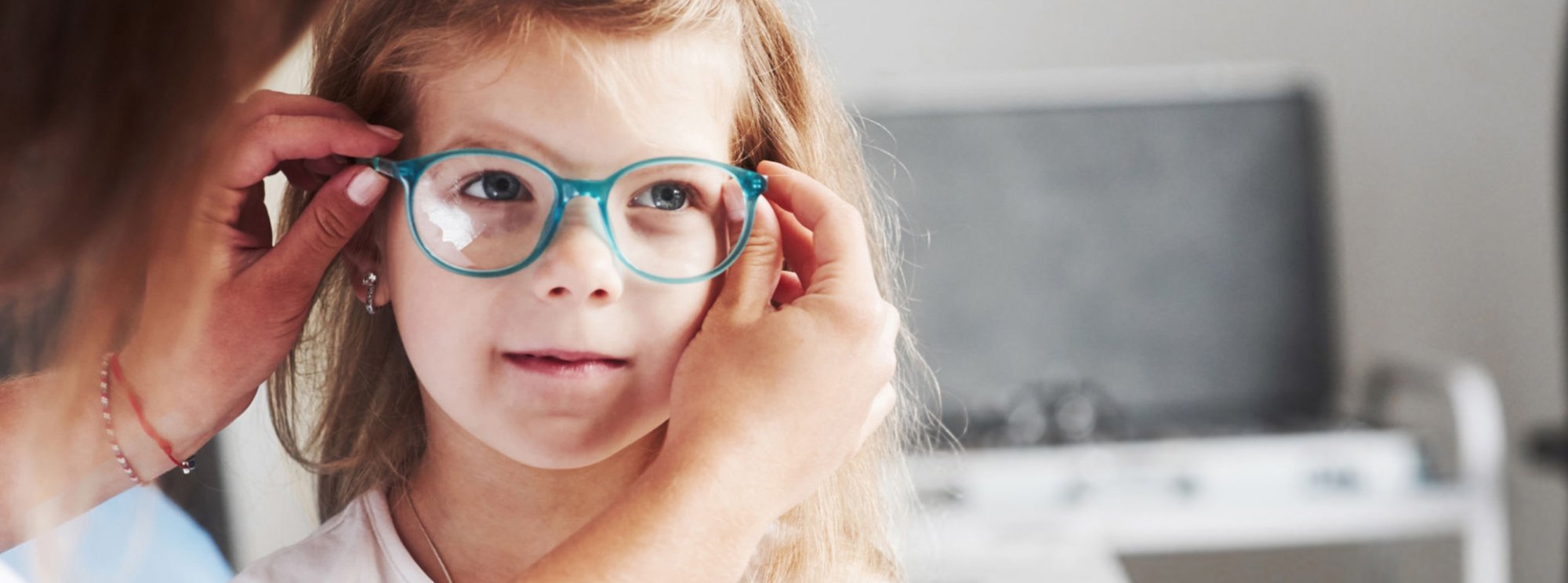Your Child and The Eye Exam
Children aren’t born with good vision, but rather with visual potential, which improves as the eye and brain develop after birth. Visual development takes place within the brain during the first several years of life, and just like learning a language, a child’s brain is learning to see the world around them. Any problems within the eyes can interfere with a child’s visual development.
80% of our tasks are visually-oriented. Therefore, good vision is necessary for learning to read, as well as for social development, behavior and coordination.
Because most children have nothing to compare to what they are seeing, they often do not complain if there is a vision problem. Children are often screened by their pediatrician for eye infections, abnormal pupils, and for vision. We recommend your child see a pediatric eye care specialist at least once prior to attending kindergarten, or at any time that you as a parent or the pediatrician have a concern, or if there is a family history of eye problems.
Children are not small adults, so their eye problems and treatments are often different from those seen in adults.
Common Vision Problems Affecting Children
The list of problems that can affect children and their visual development is quite long. Below is the most common vision problems affecting children:
Refractive Error (need for glasses to improve vision)
- Nearsightedness (Myopia): Objects at distance are blurry and objects closer are clearer. May get worse as the child grows taller or with frequent use of phone/computer. Typically associated with a longer length eyeball.
- Farsightedness (Hyperopia): Objects close are blurry, but objects at distance may also be a little blurry. Often present at birth; many children will outgrow hyperopia as their body gets taller. Typically associated with a shorter length eyeball.
- Astigmatism is when there is more than one focus point for light entering the eye, and can be caused by an irregular shape of the cornea. If a child has astigmatism, you may notice the child tilting the head and squinting the eyes when watching TV.
What if my child needs to wear glasses?
- Most children will recognize that they see better with their glasses and will leave them on. Some children do not accept change easily or will resist having glasses on their face. Start with getting a good pair of eyeglasses fitted by an experienced optician. The glasses should fit so that the eyes are within the center of the lens. The glasses should not be constantly sliding down the nose, as the child may look over the top of the lenses and defeat the purpose of the glasses. Sometimes using a strap around the head to keep the glasses in place is helpful.
- A positive attitude on the part of the parents is extremely important. Praising the child for keeping the glasses on, engaging in one-on-one activities that keep the child’s hands busy and the mind distracted will help at the beginning. If the child is extremely strong-willed and refuses glasses despite all efforts, it is best to discuss other options with your physician.
Strabismus (eyes misaligned or not straight)
- Nearly 3% to 5% of children have strabismus, which may be manifested by drifting outward or turning inward of the eyes.
- Sometimes children with strabismus may hold their heads tilted or turned to one side.
- This can occur at any age. It is unusual for the child to complain of any vision problem.
- Often the misalignment is noticed by the parents, pediatrician, teacher, or friends at school.
- Typically, strabismus in children is an isolated problem, which can be associated with decreased vision. Rarely, it may be a sign of more serious eye conditions or neurological disease.
- Treatment of strabismus depends on a number of factors identified in the complete eye exam and is tailored to your child’s needs to ensure good vision. Some treatments may include: wearing eyeglasses, patching of one eye, or surgery.
- All children with suspected misalignment of the eyes should see a pediatric eye care specialist for evaluation.
Amblyopia (“lazy” eye with poor vision)
- Nearly 2% to 3% of children have amblyopia.
- Often if not treated by age 6 or 7 years old, it cannot be reversed later in life. Therefore, it’s important that any child with suspected amblyopia see a pediatric eye care specialist for appropriate evaluation and treatment. Otherwise, the vision in the affected eye(s) may be lost for life.
There are three major forms of amblyopia:
- Amblyopia due to refractive error
- Amblyopia due to strabismus
- Amblyopia due to obstruction of vision (for example, by a cataract or droopy eyelid over central pupil)
Blocked Tear Ducts
- Many infants experience tearing due to blocked tear ducts. This will manifest as tearing, crusting of lids, and discharge from the involved eye(s).
- In most cases, massaging of the lacrimal sac or use of antibiotic drops or ointment will help.
- In many children, the problem will resolve spontaneously between ages 12 to 15 months.
- In some cases, the ducts remain blocked. A procedure to open the ducts can be performed.
- Tearing can also occur with infections or in childhood glaucoma, so it is important for the child to be evaluated by a pediatric eye care specialist to make the appropriate diagnosis and treatment plan.
Eye Infections
- Through school and play, children are frequently exposed to ocular infections. These infections can be quite dramatic in children, sometimes requiring medications.
- If your child has red eye, severe discharge from the eye, swelling or redness of the eyelid(s), fever, or bumps around the eye, the child should be seen urgently by a pediatric eye care specialist. Topical or systemic antibiotics may be required.
Eye Allergies
- The eyes can be very sensitive to environmental allergens, especially in young children.
- Children with a history of asthma or rhinitis (runny nose) may be particularly bothered by ocular allergies.
- Avoiding the ocular allergens and using cool compresses may help with symptoms.
- Prescription eye drops and sometimes systemic medications might be necessary to alleviate symptoms and improve vision.
Eye Injuries
- Children are at risk for injury at any time, from chemicals, pencils, fireworks, BB guns, or from sports injuries (for example, football, baseball, or basketball thrown at them).
- Some injuries, like scratches to the front surface of the eye, can be evaluated and treated with minimal risk for permanent damage.
- Other injuries to the eye can cause permanent, irreversible vision loss if not treated immediately.
- Children between 11-15 years old have a higher incidence of severe eye injury compared to other age groups, and boys outnumber girls with eye injuries by 3:1.
- Many eye injuries could be prevented with appropriate adult supervision and by regular use of protective eyewear during sports.
- Any time you suspect an eye injury, immediately proceed to your nearest emergency room. It is important to first ensure there are no other physical injuries. Sometimes an x-ray or other radiologic imaging needs to be obtained. A pediatric eye care specialist will then become involved if there is a need for further treatment or surgery to try to recover vision.






